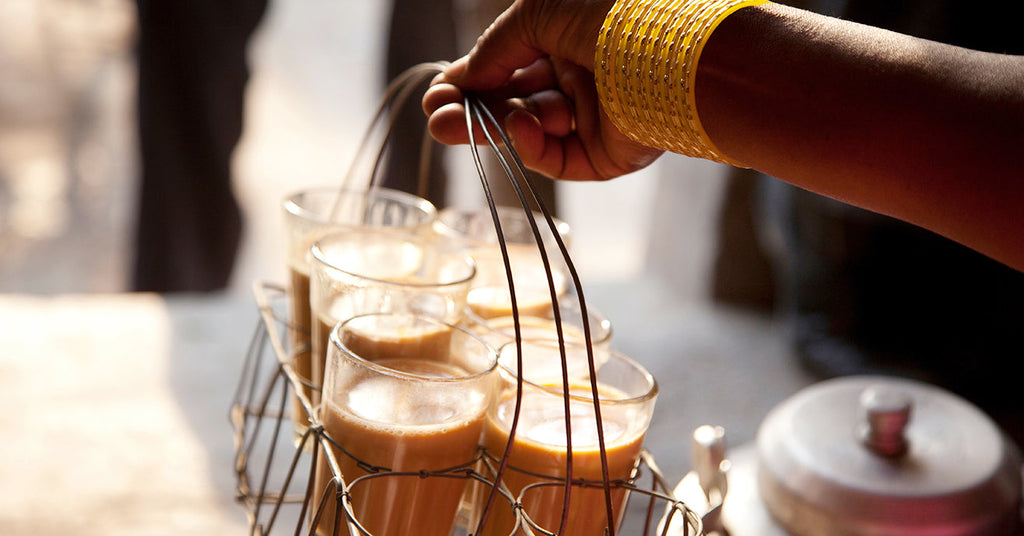Chai: India's National Drink

When I was fortunate enough to travel to north India with our founder, Raj, chai was difficult to avoid. (Though why would you want to?) This ubiquitous beverage is the unofficial national drink of India and a steamy staple along roadsides throughout the country.
And it's a common drink of choice in the tea fields too. While visiting with the women farmers who hand-harvest our Organic Kumaon Black and Organic Kumaon White teas, Raj and I took a very memorable chai break in the lush, green tea gardens of Champawat. One of the farmers motioned for me and Raj to sit down next to her. Squatting in the dirt next to her fellow farmers, circled around a teapot full of homemade chai, she handed each of us a small, steel cup. She then poured the piping hot beverage into the metal vessel, encouraging us to drink. Not one to turn down a cup of tea, we obliged. And it was delicious! Not unlike the chai I've been accustomed to ordering at coffee shops in the US, the familiar flavors of ginger and cardamom were perfectly balanced by the strength of whatever black tea she'd brewed.
What is Chai?

Many say the word originated in China. In Cantonese, "cha" is the word for "tea." In many other languages “chai” translates to pure “tea,” but in India, it refers to the aromatic and tantalizing concoction of warming, gut-friendly spices infused with black tea leaves. Typical spices found in chai include cardamom, ginger, cloves, and black peppercorn. It's often sweetened with sugar and lightened with milk or cream. In the US, it may get an added shot of espresso (my personal favorite iteration to kickstart the day) in what's called a "Dirty Chai."
Where Did Chai Originate?
Although India has only produced tea on a massive scale since mid-1800s (when the British introduced native Chinese plants to Indian soils), the hot beverage was quickly embraced. Chai is basically the "Indianized" version of the Brits' sweetened black tea with cream combo. When the beverage came to India's shores, locals added popular digestive spices from Ayurveda. While it feels like chai's been around forever, it's really less than 200 years old, which is new by Indian cultural standards.

Although India produces a wide range of teas ranging from sophisticated, perfumed, and fragrant Darjeeling teas to bright, creamy Nilgiri teas, most of the teas used in chais come from the malty, thick varieties made in Assam. These robust teas can hold their weight against the powerful blend of spices, sugar, and milk that make the typical cup of Indian chai complete.
While chai in India can be made at home, it's common to see it sold on the streets in India. Chai Wallahs—men who serve and sell chai—preside over their boiling cauldrons on roadsides and in markets. Each chai wallah tends to his own mix of dried spices along with finely grated fresh ginger and boiled with loose black tea leaves.
When a cup of tea is ready to serve, the chai wallah will strain out the loose tea and spices, leaving the tea in a metal saucepan. Then, with saucepan in hand, he'll raise his arm above his head, and quickly pour the brew from a great height into small tea cups. Part showmanship and partly a technique for cooling down the boiling beverage, his customers sip on the tea while hovering around the chai stand. It's a communal affair, a time for folks to catch-up with friends, the news, or just enjoy a break from the bumpy road ahead.
Traditionally, chai wallahs served their fare in terracotta cups crafted by local potters. These single-use vessels were quite hygienic. After the customer is finished with their drink, they throw the cup on the ground, smashing it into pieces. Reusable metal or porcelain cups are more common these days, but you can still find the terracotta cups every once in a while.

Teas used in making chai are often processed in a way known by the tea industry as CTC (Cut Tear Curl). This method of breaking the leaf into smaller pieces was developed specifically for tea bags. When steeped, the coarse tea material releases all its flavor in a single infusion. Because the tea is meant to be steeped only once, it's tough to over-steeping, preventing a bitter cup. This tea type works well for making chai, as the tea leaf is often boiled for quite some time with the spices to create a more aromatic experience.
How Chai is Made
As a loose-leaf lover, I typically make chai with our Organic Assam Black and a collection of organic spices in my pantry. I keep the brew of spices on the stove for hours, bringing it to a boil every time I want a cup. Once the flavor is too weak, I compost the spices and begin the brewing cycle again. You can get our recipe for a DIY chai at home as well in our Complete Guide to Masala Chai.

You might also enjoy:

Comments on this post (1)
A beautifully brewed blog! Loved the rich storytelling around chai and the cultural depth. Truly aromatic in words and spirit.
— Sudha Academy